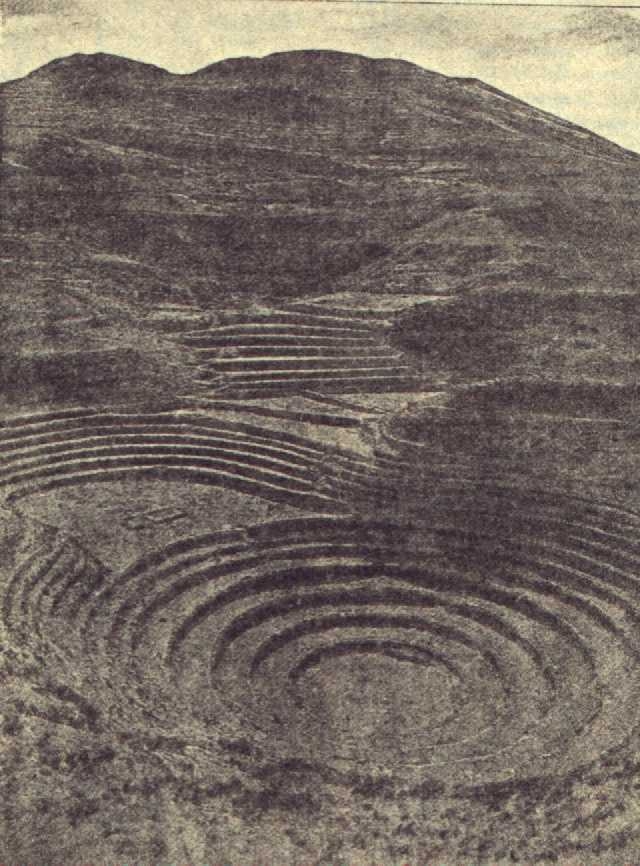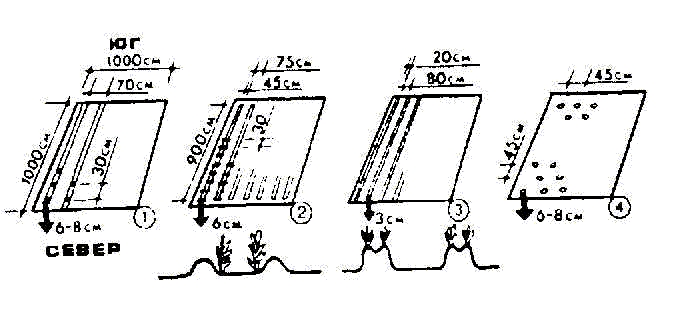First of all, let us recall the generally accepted method of growing potatoes. Since the fall of manure - 600 kg For a hundred square meters - and the ground is dug. In the spring they are again digged, leveled and made in rows of holes at a distance 30 centimeters From each other. Between rows leave 70 cm . Select for planting a tuber weighing 50- 70 grams each. If the manure has not been scattered since the fall, then in the spring already in the holes are introduced the overgrazing or half-bred manure; And will need his 200- 300 kg For a hundred. As much as it is recommended at this time to make ash and 5- 7 grams (A teaspoonful ) of nitroammophoski . Sprouted tubers are laid out to a depth of 6- 8 centimeters . Earth after landing is leveled. Before emergence, the ground is loosened again to remove the crust. Twice a season, after a rain or plentiful watering, planting hills.
For one hundred we spend 22- 30 kg Potatoes or 435 tubers. Harvest - about 200 kg From hundred parts.
The technology of Vladimir Petrovich Ushakov, who works in the Solnechnogorsk district of the Moscow region, is based on the use of manure recycled into biohumus and a particularly careful attitude to soil organisms, which he calls "living matter".
In early March, in the manure packs VP. Ushakov punches a hole to the ground to the ground and by the end of April receives a semi-pereprevshuyu mass containing many earthworms and microorganisms.
The processing of land Vladimir Petrovich begins quite late, from April 28 to May 15, when at a depth of 10- 12 centimeters The earth will warm up to 8-10 0 . He does not make beds. The soil loosens to the depth 15 centimeters Pitchfork without turning over the seam, spreads and places the holes evenly over the entire surface. Each hole in it is in all directions from the neighboring holes at a distance of 45 centimeters (By the principle of an equilateral triangle). It makes them sufficiently wide and deep
15 centimeters
.
In each falls asleep about
700 g
Perepredvshego manure with worms and covers the top layer of soil in a 2-
3 cm
.
Sprouted tubers weighing 70-
90g
With 5-7 sprouts planting at a depth of 6-
8 centimeters
.
Closes the top soil, taken during the digging of the next hole, without turning the bed.
When the potato tops grow to 20- 25 centimeters , Conducts a circular hilling just one time, leaving the upper 5- 8 centimeters Haulm.
No further care, including watering, is required.
Harvesting the potatoes. Ushakov not later than the second half of August.
According to this technology on the lighted area, fertile soil and under favorable weather conditions, the grade "Belarusian Pink" gave a record result - 1150 kg From hundred parts! The variety "Blue Eyes" under the same conditions - 700 kg . On poor soils, potato yields grown by the Ushakov method are reduced by a factor of 2, and if the plot is not very well illuminated, then in 4 times.
Spends on VP. Ushakov for one hundred weights 40-50 kg of potatoes or 550 tubers.
American vegetable grower Dr. Mittlayer potatoes, like other vegetables, grows on narrow ridges in width 0.45 m And length 9 m With aisles not less than 75 cm . On the day of planting on unplunged soil introduces pre-sowing fertilizer - mixture No. 1 and mixture No. 2. After applying fertilizer, the soil is dug up and forms ridges with bumps. Sprouted tubers weighing 50-70 g plant at a distance 30 centimeters From each other on the inside of the sides. When there are shoots, begins feeding - 4 times with an interval of 4-10 days. For this purpose, fill a narrow strip in the center of the ridge 450g Mixture No. 2 and dissolve with watering. In dry weather, it continues to water after the end of feeding. Especially important is watering, when buds are also picked during the flowering period.
Some scientists believe that during the Incas on such round terraces potatoes were cultivated in
50 km
From the famous Inca capital Cuzco .
Planting potatoes in a conventional way by the method of Mitlander , Bulanov , Ushakov.
For more even illumination, rows should be positioned from north to south.
Potatoes Mittlayer does not loosen and do not bother, some of the tubers are sometimes close to the surface and can turn green. Therefore, during budding it is recommended to cover the planting by 2-3 cm.
On the sotka Mittlajder places 8 ridges, spends 25-35 kg of potatoes or 490 tubers. From each ridge receives in autumn 70 kg Potatoes, harvest from a hundred 550 kg .
His method resident of the Tula region Viktor Alekseevich Bulanov developed for 8 years. In the fall, he contributes 600- 800 kg Manure and digs the earth onto the spade bayonet (to the depth 25 centimeters ). In the spring before planting, the main mineral fertilizer is introduced : p is distributed along the soil surface 5 kg Nitroammophoski (labeled 17-17-17) and again digs up, but already to the depth 15 centimeters . The site is leveled and divided into unequal in width bands: for a 20-centimeter strip there is a strip of width 80 cm , Then again 20 centimeters etc. The direction of the bands is strictly from north to south. Along the boundaries of 20-centimeter strips, directly on the surface of the soil, sprouts the sprouted potato tubers at a distance 30 centimeters From each other. On the newly formed double rows of tubers lying on a flat ground, he heats the earth from wide strips so that the tubers cover only 2-3 cm.
As the tops of the potato grows, the potatoes dip at least three times (in the spring, in the event of a cooling, the young tops are recommended to be highly populated).
Feeding V.A. Bulanov begins in early summer after the onset of stable warm weather. Three times per season, with an interval of approximately 10 days, it contributes to the running time of the two 50 grams Nitroammophoski - in the hollow between the rows. Fertilizes before rain or combines top dressing with watering. So that the fertilizer solution does not drain, when dividing the section at the ends of the rows, it makes the borders from the ground.
When the tops close, the feeding ceases, and the tops of the neighboring rows fall over one another and bite so that a flat mound is formed without a hollow in the middle. From this time only periodically weeds, and in dry weather watering (sprinkling).
Shortly before harvesting, the logs are rolled by a log and leaves in such condition for about a week. After that, he mows it at a height of 15- 20 centimeters , And a few days later the potatoes are digging.
On the sotka VA. Bulanov spends 30-40 kg of potatoes or 590 tubers with a mass of 50- 70 grams . The harvest of 600- 700 kg From hundred parts. You can get up to a ton from a hundred!
In the summer of 1991, VA. Bulanov studied at Dr. Mittlayer at the agricultural department of the seminary. In the future, he proposes to combine the advantages of balanced nutrition of plants on Mittlayderu with his method.
For the second year he has been growing potatoes on a new two-tiered method proposed by Oleg Y. Georgiev from the Krasnodar Territory, an experienced horticulturist with a great experience Marina Yanovna Stein from the Moscow Society for the Conservation of Nature. The plot for potatoes is divided into strips in width 30 centimeters With intervals between them 60-70 cm. For each 3.5 m Contributes 8-10 kg of humus and 0.5 kg Ash. Dug and along the edges of the strips on both sides makes grooves deep 8 centimeters . In the first furrow, a potato the size of a chicken egg is laid out at a distance 30 centimeters From each other, and in the other at the same distance, but having receded from the edge 15 centimeters . Thus, the potatoes in the second groove are staggered in relation to the first. Ridges fall asleep and proceed to plant the second tier of potatoes. Stepping back from the beginning of the first furrow 15 centimeters , She spreads the tubers at the same distance 30 centimeters From each other, but already on the surface of the soil. In the second furrow from the opposite side of the tuber also disposes on the surface of the soil, but in staggered order. Above the rows of potatoes fall asleep to the depth 3 cm Earth from the tracks. So, in each furrow you get two vertical rows of planting: one at a depth 11 centimeters (8 + 3 cm) and the second at depth 3 cm , And one tuber is shifted relative to the other on 15 centimeters .
When the potatoes grow to 10-15 cm, Marina Yanovna bows it to the height 20 centimeters Only once per season. The land for hilling takes from the tracks. As a result, each ridge takes the form of a trapezoid with four rows of potatoes - two rows at a depth 31 centimeters And two others at depth 23 centimeters . Each of the two rows does not interfere with the other, being in the vertical plane.
He watered and, if necessary, fed M. Shtein's planting only before flowering. The crop is cut off two weeks before harvest, leaving hemp height of 7- 10 centimeters .
The digested potatoes are treated with concentrated hydrochloric acid (1-2 grams per 10 l water). Lower the tubers for 1-2 minutes, after two or three times the use of the solution changes. After such treatment, the potatoes do not deteriorate, it can be directly moistened to be poured into storage.








Comments
When commenting on, remember that the content and tone of your message can hurt the feelings of real people, show respect and tolerance to your interlocutors even if you do not share their opinion, your behavior in the conditions of freedom of expression and anonymity provided by the Internet, changes Not only virtual, but also the real world. All comments are hidden from the index, spam is controlled.